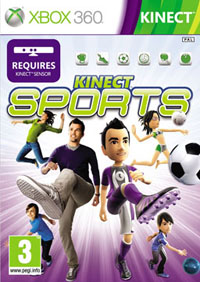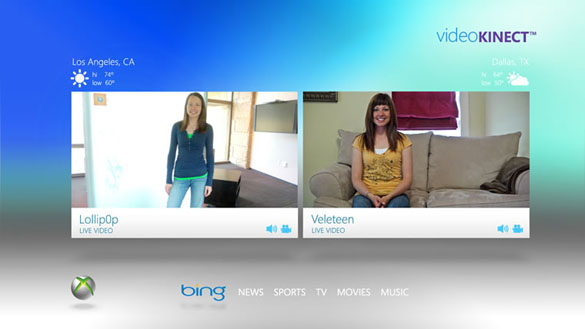Kinect Review: Are games just the beginning?
A lot has been made of Microsoft’s Kinect, the new motion detection system for the Xbox 360. It has lead many to draw comparisons to the gesture controls seen in Minority Report, and go so far as to say that it may even change the face of computing in the future. That’s high praise indeed, but what does it mean for gaming right now?
You’ve probably seen all the advertising surrounding the Kinect, making you the controller. The sensor itself, just about a foot long, is mounted on a heavy base, and is motorized so it can tilt, allowing it to be placed at different heights. The body is comprised of an infrared emitter, a greyscale CMOS camera and a colour camera. The emitter covers the play area with thousands of points of IR light, which the CMOS sensor uses to determine the 3D space in front of it, in conjunction with a standard RGB colour camera. The sensor also has an array of four microphones for detecting room sound. More on that later. If you have the new smaller Xbox, you simply plug the Kinect into the back of the console, which supplies the console with both data and power. For older Xbox 360 models, the Kinect comes with a separate AC adapter for power.
The biggest controversy surrounding the launch of the Kinect is the amount of space needed to play. You really need 6 feet away from the sensor for a single player experience, and 8 to play two player. Given my oddball layout, I ended up having to put the Kinect off to the side, while rotating the TV, which mostly worked, except in some extreme positions when playing two player games, where the Kinect couldn’t detect anything below the knees. In most cases you shouldn’t have this problem, but be prepared to move your coffee table. In fact, even if you DO have the room, moving the coffee table might be a good idea, because the Kinect really does get you moving, and there’s already a few ‘incidents’ logged on YouTube. Not as bad as putting your WiiMote through your brand new HDTV, but it’s a distinct possibility.
Once the physical setup is done, it’s time to configure the software. When you first turn on the 360 with the Kinect hooked up, there’s a straight forward guide taking you through the basics. At this point, the need for the microphone array comes in, as it plays a series of sounds to map out your speaker setup, to help with voice commands. The Kinect will also tilt to find it’s optimal angle, complete with a subtle Johnny 5 servo noise action. The tour, only takes a couple of minutes and the basics are done. As soon as this is finished, you can also link your Kinect ID to your Gamertag, where the system scans your face to allow you to be recognized by the system when you step in front of it.
In my case this went smoothly, but a number of reports suggest that if you wear glasses, the Kinect may have issues identifying you, especially with thicker frames.
Kinect Dashboard
When you engage the Kinect Dashboard, instead of being presented with the crossbar paradigm of the regular Xbox 360 Dashboard, you’re presented with 8 panels, such as the Avatar, and available games. To engage any program, you simply move your hand in the air to the appropriate one, and hold it for approximately a second to select it. During this time, a circle fills up to give you a visual que, and once full, the item is engaged. With only 8 panels per screen, the user can navigate between panel sets by grabbing the appropriate arrow on the left and/or right side and swipe in the direction as needed. This is the Minority Report effect, though instead of instant gratification, you have to hover your hand over the arrow for approximately a second before it engages.
Other programs such as the Zune Marketplace and Avatar editing can also be handled with the Kinect, and while it does work, it’s certainly not as fast as using a controller. I do have to admit that searching the Zune Marketplace with motions was pretty fun, as you swipe your hand across an alphabet and drag letters into the search box, though Xbox Chatpad users will definitely be sticking to typing there.
Another impressive feature is Video Kinect, which allows Kinect users to do video chat from the comfort of the couch. When you launch a video chat, the camera zooms in and crops to fit you on screen, and is aware of multiple people in it’s space. For example, if you’re chatting with a friend and someone else walks in and sits down, the camera will zoom out to re-crop the frame. Video Kinect also allows you to communicate with Microsoft Messenger. It’s not a killer feature, but having that integration is a nice bonus for users of the service.
Most of the Dashboard features can also be controlled via voice, including telling it to launch Kinect, and controlling playback of video from Zune. I can see voice control of video play/pause being especially useful if you’ve set the remote down and the phone rings.
Kinect Adventures
 Kinect Adventures, which ships with the Kinect, is also one of the best demonstrations of the Kinect’s abilities. Each of the games requires different types of motions, and the graphics are pretty impressive, as developer Good Science Studios made use of the Unreal Engine for the graphics.
Kinect Adventures, which ships with the Kinect, is also one of the best demonstrations of the Kinect’s abilities. Each of the games requires different types of motions, and the graphics are pretty impressive, as developer Good Science Studios made use of the Unreal Engine for the graphics.
River Rush, a one or two player co-op game, has your Avatar(s) standing in a raft that navigates increasingly treacherous waters to collect point by steering and jumping. I found this to be a little awkward in two player mode, but single player was a blast. Since each ride is fairly short, this makes for a pretty good party game amongst a group of friends, to see who can get the most points on any particular course. If you’re of legal drinking age, I can attest to the fact that after a couple of drinks it becomes even more fun.
Reflex Ridge is another on rails game with a different set of motion altogether. Your avatar stands on a simple wheeled platform that moves along a rollercoaster type track. Along the way, there are Adventure Points to pick up, and obstacles to dodge, by ducking, jumping and stepping left or right. This made for another fun party game, since the 2 player mode is actually a split screen. Rapidly jumping up and down makes your platform move faster, which can be quite exhausting. Unfortunately, it’s a bit of a drawback as well. While jumping up and down, it’s harder to concentrate on the screen, which can often lead to missing out on some of the obstacles that need to be cleared.
Rally Ball is basically a mix of Arkanoid and Dodgeball, in which you use your Avatar’s arms, legs and head to bounce a dodgeball at a series of bricks. The gameplay gets pretty addictive in short bursts, especially when you have multiple dodgeballs flying at you at once.
20,000 Leaks traps you in a glass cube submerged in the ocean. The only problem is, fish are attacking the tank, causing cracks to appear and water to leak in. To plug the leaks, you need to use your hands, feet and head, in various combinations and sometimes all at once. Though a good demonstration of the exact positioning of the Kinect, this one came off as more of technology demo wrapped in a game than something one would want to visit time and again.
In the fifth mini-game Space Pop, you’re in a zero gravity room, in which transparent spheres appear in the room and your goal is to collect them by moving around in the space by stepping forward and back. Since the room is a couple of stories high, you can fly up by flapping your arms, and drop back down by holding them down at your sides. This game took the most coordination I found, but like 20,000 Leaks came across as more of a demo than the other 3 games.
Since the game is packed with the Kinect, you’re going to get it anyways. That doesn’t mean it lacks value though. Both Rally Ball and River Rush are fun in their own right, and Reflex Ridge comes close, other than the speed control decision.
Kinect Sports
 Kinect Sports has drawn a lot of comparisons to Wii Sports, and for good reason. Like the Wii title, it’s comprised of a number of sport games, in no particular order: Bowling, Boxing, Football (Soccer), Ping Pong, Track and Field (which includes Hurdles, Sprint, Javelin, Discus Throw and Long Jump) as well as Volleyball.
Kinect Sports has drawn a lot of comparisons to Wii Sports, and for good reason. Like the Wii title, it’s comprised of a number of sport games, in no particular order: Bowling, Boxing, Football (Soccer), Ping Pong, Track and Field (which includes Hurdles, Sprint, Javelin, Discus Throw and Long Jump) as well as Volleyball.
What makes Kinect Sports work is that Rare has done a great job of defining the controls for each of the games. You jump and spike in Volleyball, and after a bit of practice you get a feel for what kind of delivery you’re going to make. Ping Pong is a lot of fun against another player, and although you’re not holding a controller, you feel as though your motions account for something. Ping Pong did seem to do some weird character animations though, with your avatars forearm going through it’s leg an the such.
Bowling is what stood out to me though. My parents came to the city to do dinner, so I showed them Kinect. We played a few Kinect Sports games, and bowling turned out to be an interesting experiment, since they’ve had a Wii for a couple of years. On the Wii, I actually do pretty well at bowling, once you find the right motion for the controller. I can’t get a strike every time, but can spare up pretty easily. On Kinect, my game score is more reflective of my real worl bowling capabilities, which is not so good. Conversely, my mom never really enjoyed bowling on the Wii an never got used to the trigger mechanism. With the Kinect, she immediately did a lot better, right out of the gate, and found it much more intuitive.
Though the graphics are less impressive than the Kinect Adventures pack-in, Rare deserves kudos for coming up with natural feeling control schemes across the board. Football, Ping Pong and Volleyball are the ones that I went back to, especially when playing multiplayer.
Joy Ride
 Originally destined to be an Xbox Live Arcade title, until it was Kinectified, Joy Ride is overall a fairly disappointing experience. Using your hands to steer a car driven by your avatar, Joy Ride has a number of play modes, including a potentially fun Stunt mode, where you drive around a massive half pipe, trying to collect objects in mid air. The controls however, are pretty finicky, as you grip an invisible steering wheel in your outstretched hands. There’s a power boost you can charge up by pulling back on the wheel, then push forward to engage, but the mechanism is sloppy to say the least.
Originally destined to be an Xbox Live Arcade title, until it was Kinectified, Joy Ride is overall a fairly disappointing experience. Using your hands to steer a car driven by your avatar, Joy Ride has a number of play modes, including a potentially fun Stunt mode, where you drive around a massive half pipe, trying to collect objects in mid air. The controls however, are pretty finicky, as you grip an invisible steering wheel in your outstretched hands. There’s a power boost you can charge up by pulling back on the wheel, then push forward to engage, but the mechanism is sloppy to say the least.
Honestly, I wish I could say better of it, but when the controls are impossible to master, it’s more aggravating than anything else.
In the end
Kinect is clearly about more than gaming, as evidenced by the thougt that Microsoft has put into the Dashboard control schemes and services like Video Kinect. It really does show off the potential for natural interfaces, not just on the console, but computing in general. On that front, it’s one of the most impressive gaming technologies to come out in a very long time. There are other games I’ve had a chance to try out, but not enough to review them. Many of them have their own ways of handling their UI. If the Kinect is successful, I can see future Dashboard updates including more responsive motion controls, as users become more accustomed with the system.
Although Microsoft doesn’t endorse it in any way, in the short time that it’s been out, we’ve seen a number of drivers and programs starting to appear on other operating systems, such as the below video from Oliver Kreylos (via Engadget). Though Microsoft is certainly aiming the Kinect at Xbox users, the underlying technology opens up new avenues of human-computer interface development.
For gaming, however, it’s still up in the air. The launch titles show off the best and the worst of the system, but the potential is huge. Many ‘hardcore’ players tend to box themselves into an argument that “oh you’ll never play Call Of Duty this way so it’s pointless”. That’s the wrong way to think about it. Introducing a new full body control mechanism is going to take developers time to grapple with, an come up with new and inventive types of games that make use of the possibilites. Personally, I’m looking forward to seeing how Child Of Eden will work with a natural interface.
Only time will tell if that will happen. In the meantime, the Kinect is definitely worth checking out, as the cost of entry is fairly low.








[…] This post was mentioned on Twitter by Doug Groves, rgbFilter. rgbFilter said: Kinect Review: Are games just the beginning?: A lot has been made of Microsoft’s Kinect, the new motion detectio… http://bit.ly/aIUQM4 […]
[…] intuitive, but the beauty of it is that it really capitalizes on the technology and essence of the Kinect. Unlike Kinectimals, there isn’t a time to sit down since load times are generally swift and […]
[…] has put out no shortage of impressive tech demos, some which evolve into consumer products like the Kinect, and others either geared towards institutional use such as the Surface, which in some cases […]